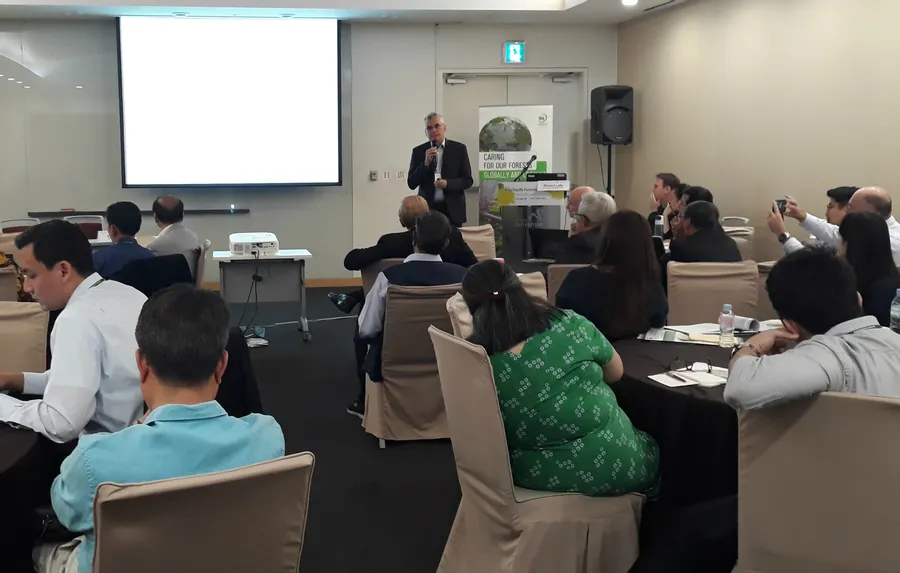FLEGT VPA and PEFC certification synergies: the future looks bright in Vietnam
Interesting outcomes at the PEFC APFW event ‘Development of synergies between PEFC and other initiatives such as FLEGT'.
FLEGT VPA and PEFC certification synergies: the future looks bright in Vietnam
19 August 2019 Event report
Sustainability and legality initiatives such as PEFC forest certification and FLEGT VPA are increasingly running parallel in many Asian tropical countries. However, there is still limited coordination between these initiatives within the same country as well as among nation states.
Ensuring meaningful coordination and synergies between these initiatives was amongst the key messages promoted at Asia-Pacific Forestry Week 2019 (APFW). The topic was delivered through the PEFC International APFW joint-event 'Development of synergies between PEFC and other initiatives such as FLEGT, utilizing experience in ASEAN'.
Participants recognized that FLEGT Voluntary Partnership Agreement (VPA) and voluntary forest certification (PEFC) have different development backgrounds, political scopes, operational procedures, and address certain aspects of the ultimate goal of sustainable forest management.
One main difference is their management goal. PEFC certification promotes sustainability of forest management, balancing societal, environmental, and economic benefits and forestry law compliance of forestry production; while FLEGT VPA focuses on the timber legality and legal enforcement. PEFC’s management scope is broader than FLEGT VPA’s.
Moreover, FLEGT VPA, a legally binding bilateral trade agreement between timber-producing countries and the EU, is compulsory and applies nation-wide. By contrast, PEFC certification is a voluntary, market-based forest instrument, working at the forestry unit or supply chain level. Even though PEFC certification could become regulatory depending on each nation’s strategy.
Complementary initiatives
Despite the differences mentioned above, all speakers emphasized that FLEGT VPA and PEFC certification are complementary initiatives, share many commonalities and strongly urged for prompt and greater synergies between the two.
For instance, both use performance standards to measure their effectiveness, Timber Legality Assurance Systems (TLAS) for FLEGT VPA; and Sustainable forest management and Chain of Custody standards for PEFC. Multiple stakeholder involvement is the core and is deliberately maintained in all development stages. Verification tools are used to ensure operators meet all requirements before issuing certificates or FLEGT licenses.

“FLEGT VPAs and certification operate at different levels, but each can integrate elements of the other,” Alexander Hinrichs, European Forest Institute explained.
Synergies are believed to yield substantial benefits in facilitating trade among regions and nations, and improving cost-effectiveness, market access and competitiveness for timber-based business operators as having both certified and legal timber claims.
A closer look at Vietnam
In a similar note, Bruno Cammaert, FAO-EU FLEGT Programme, highlighted that “it is crucial to think of the synergies of the two initiatives as early as possible. FAO-EU FLEGT Programme has resource availability and is ready for supporting this effort”.
This advice is particularly helpful for countries like Vietnam, which is at the decisive phrase of finalizing the structures for FLEGT VPA Vietnam operations and developing the national Vietnam forest certification scheme (VFCS) for PEFC endorsement.
There are many possibilities for synergies...
On the one hand, PEFC/VFCS certified timber could be exempted from, or subject to less intensity of, the timber legality verification processes under FLEGT VPA, compared to non-certified timber. FLEGT VPA Vietnam authority could also request that imported timber to Vietnam, which would like to have FLEGT licenses, needs to have a PEFC certificate or PEFC controlled source claim. PEFC/VFCS standards and verification processes should be integrated into the Organization Classification Systems under VN-TLAS to assess the risk of operators.
On the other hand, VPA-TLAS should also be recognized by certification systems. Legal timber verified under TLAS as meeting some additional requirements such as no forest conversion associated with its production, could obtain PEFC controlled source claims. The high-level government of Vietnam shares the same vision and their commitment is strong.
Dr. Bui Chinh Nghia, Deputy Director of VFCS committed that “VFCS will try its best to make sure the synergy between VFCS/PEFC and FLEGT VPA Vietnam will be realised. We are in a good position for such a synergy negotiation given these two initiatives are responsible and led by the same leading government agency of the forest sector, the Vietnam Administration of Forestry (VNFOREST)”.
The event provokes an optimistic future for FLEGT VPA and PEFC certification synergy and integrity not only in Vietnam, but also in the ASEAN region.
“PEFC International is working progressively with ASEAN nations to facilitate regional coordination for maximizing synergies between national forest certification systems and FLEGT VPA. We are looking forward to stronger collaborations to materialize this strategy in the region," concluded Richard Laity, PEFC International.
